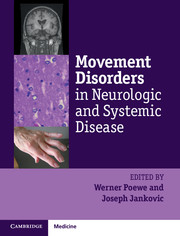Book contents
- Frontmatter
- Contents
- List of contributors
- List of videos
- List of abbreviations
- Preface
- Section I General principles
- Section II Movement disorders in systemic disease
- Section III Iatrogenic and toxic movement disorders
- Section IV Movement disorders in general neurology
- Chapter 17 Movement disorders in stroke
- Chapter 18 Movement disorders in multiple sclerosis
- Chapter 19 Movement disorders in neoplastic brain disease
- Chapter 20 Movement disorders in encephalitis
- Chapter 21 Sleep-related movement disorders
- Chapter 22 The borderland between epilepsy and movement disorders
- Chapter 23 Movement disorders associated with neuromuscular disorders and peripheral neuropathies
- Section V Systemic complications of movement disorders
- Index
- Plate Section
- References
Chapter 22 - The borderland between epilepsy and movement disorders
from Section IV - Movement disorders in general neurology
Published online by Cambridge University Press: 05 April 2014
- Frontmatter
- Contents
- List of contributors
- List of videos
- List of abbreviations
- Preface
- Section I General principles
- Section II Movement disorders in systemic disease
- Section III Iatrogenic and toxic movement disorders
- Section IV Movement disorders in general neurology
- Chapter 17 Movement disorders in stroke
- Chapter 18 Movement disorders in multiple sclerosis
- Chapter 19 Movement disorders in neoplastic brain disease
- Chapter 20 Movement disorders in encephalitis
- Chapter 21 Sleep-related movement disorders
- Chapter 22 The borderland between epilepsy and movement disorders
- Chapter 23 Movement disorders associated with neuromuscular disorders and peripheral neuropathies
- Section V Systemic complications of movement disorders
- Index
- Plate Section
- References
Summary
Introduction
The term “borderland of epilepsy” was coined by William Richard Gowers in 1907 when he described the borderland as disorders “near it (epilepsy), but not of it” (Crompton and Berkovic 2009).
Brief paroxysmal stereotyped events are the cardinal feature in both epilepsy and paroxysmal movement disorders (PMD). A seizure is an abnormal synchronous burst of neuronal activity, with epilepsy defined as a propensity to having seizures. Epilepsy is differentiated from movement disorders by the presence of characteristic ictal and interictal discharges on electroencephalography (EEG) and events may evolve into or be associated with generalized tonic-clonic or other seizures. Cortical involvement is a key factor in epileptic seizures, with the disruption between cortical and subcortical pathways influencing the semiology of the events. Altered functioning of subcortical structures is primarily implicated in generating PMD, although hypersynchronous discharges have not been disproved as the basis for PMD (Berkovic 2000).
Unlike generalized or complex partial seizures, movement disorders, in general, do not cause impaired consciousness. However, some seizures may cause very subtle alterations in mentation and in a number of sleep-related movement disorders patients have no recollection of the events. In addition, distinguishing between epilepsy and PMD in patients with developmental delay, impaired cognition, or altered mental status may present even greater difficulty.
- Type
- Chapter
- Information
- Movement Disorders in Neurologic and Systemic Disease , pp. 333 - 351Publisher: Cambridge University PressPrint publication year: 2014

